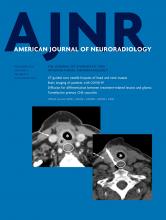Research ArticleNeurointervention
Open Access
Computational Fluid Dynamics Using a Porous Media Setting Predicts Outcome after Flow-Diverter Treatment
M. Beppu, M. Tsuji, F. Ishida, M. Shirakawa, H. Suzuki and S. Yoshimura
American Journal of Neuroradiology November 2020, 41 (11) 2107-2113; DOI: https://doi.org/10.3174/ajnr.A6766
M. Beppu
aFrom the Department of Neurosurgery (M.B., M.S., S.Y.), Hyogo College of Medicine, Hygo, Japan
M. Tsuji
bDepartment of Neurosurgery (M.T., F.I.), National Hospital Organization Mie Chuo Medical Center, Tsu, Mie, Japan
F. Ishida
bDepartment of Neurosurgery (M.T., F.I.), National Hospital Organization Mie Chuo Medical Center, Tsu, Mie, Japan
M. Shirakawa
aFrom the Department of Neurosurgery (M.B., M.S., S.Y.), Hyogo College of Medicine, Hygo, Japan
H. Suzuki
cDepartment of Neurosurgery (H.S.), Mie University Graduate School of Medicine, Tsu, Mie, Japan.
S. Yoshimura
aFrom the Department of Neurosurgery (M.B., M.S., S.Y.), Hyogo College of Medicine, Hygo, Japan

References
- 1.↵
- 2.↵
- Becske T,
- Brinjikji W,
- Potts MB, et al
- 3.↵
- Cruz JP,
- Chow M,
- O’Kelly C, et al
- 4.↵
- 5.↵
- Umeda Y,
- Ishida F,
- Tsuji M, et al
- 6.↵
- 7.↵
- 8.↵
- 9.↵
- Murray CD
- 10.↵
- Ford MD,
- Alperin N,
- Lee SH, et al
- 11.↵
- Akgiray Ö,
- Saatçı AM
- 12.↵
- Derdeyn CP,
- Chimowitz MI,
- Lynn MJ, et al
- 13.↵
- Sugiyama S,
- Niizuma K,
- Sato K, et al
- 14.↵
- 15.↵
- Chung B,
- Mut F,
- Kadirvel R, et al
- 16.↵
- 17.↵
- Mut F,
- Raschi M,
- Scrivano E, et al
- 18.↵
- 19.↵
- Tsuji M,
- Kishimoto T,
- Tomoyuki K, et al
- 20.↵
- Damiano RJ,
- Tutino VM,
- Paliwal N, et al
- 21.↵
- 22.↵
In this issue
American Journal of Neuroradiology
Vol. 41, Issue 11
1 Nov 2020
Advertisement
M. Beppu, M. Tsuji, F. Ishida, M. Shirakawa, H. Suzuki, S. Yoshimura
Computational Fluid Dynamics Using a Porous Media Setting Predicts Outcome after Flow-Diverter Treatment
American Journal of Neuroradiology Nov 2020, 41 (11) 2107-2113; DOI: 10.3174/ajnr.A6766
0 Responses
Jump to section
Related Articles
- No related articles found.
Cited By...
This article has been cited by the following articles in journals that are participating in Crossref Cited-by Linking.
- Yuya Uchiyama, Soichiro Fujimura, Hiroyuki Takao, Takashi Suzuki, Motoharu Hayakawa, Toshihiro Ishibashi, Kostadin Karagiozov, Koji Fukudome, Yuichi Murayama, Makoto YamamotoBioengineering 2021 8 10
- Aurèle Goetz, Pablo Jeken-Rico, Yves Chau, Jacques Sédat, Aurélien Larcher, Elie HachemBioengineering 2024 11 3
- S. Hadad, F. Mut, R. Kadirvel, Y.-H. Ding, D. Kallmes, J.R. CebralAmerican Journal of Neuroradiology 2021 42 11
- Katsuhiro Tanaka, Kazuhiro Furukawa, Fujimaro Ishida, Hidenori SuzukiActa Neurochirurgica 2023 165 12
- Xiaoyu Ren, Haoran Li, Kaihang Xu, Zhongkai Li, Bin Gao, Wangsheng Lu, Guangming Yang, Yunjie Wang, Yin Yin, Tao ChenInternational Journal for Numerical Methods in Biomedical Engineering 2024 40 3
- Masanori Tsuji, Fujimaro Ishida, Takenori Sato, Kazuhiro Furukawa, Yoichi Miura, Ryuta Yasuda, Yasuyuki Umeda, Naoki Toma, Hidenori SuzukiBrain Hemorrhages 2023 4 1
- Yu Fu, Xin Bian, Rong Zou, Rongbo Jin, Xiaochang Leng, Feng Fan, Sen Wei, Xuan Cui, Jianping Xiang, Sheng GuanJournal of Neuroradiology 2024 51 1
- Jun Wan, Yeqing Jiang, Ligang Xu, Qimin Zhang, Guanghu Xu, Long Yu, Xinzhuo Li, Xiaolong Zhang, Shengzhang WangBioMedical Engineering OnLine 2025 24 1
- Hongchen Zhang, Chuanhao Lu, Zhen Hu, Deyu Sun, Liang Li, Hongxing Wu, Hua Lu, Bin Lv, Jun Wang, Shuhui Dai, Xia LiCNS Neuroscience & Therapeutics 2025 31 4
More in this TOC Section
Similar Articles
Advertisement











